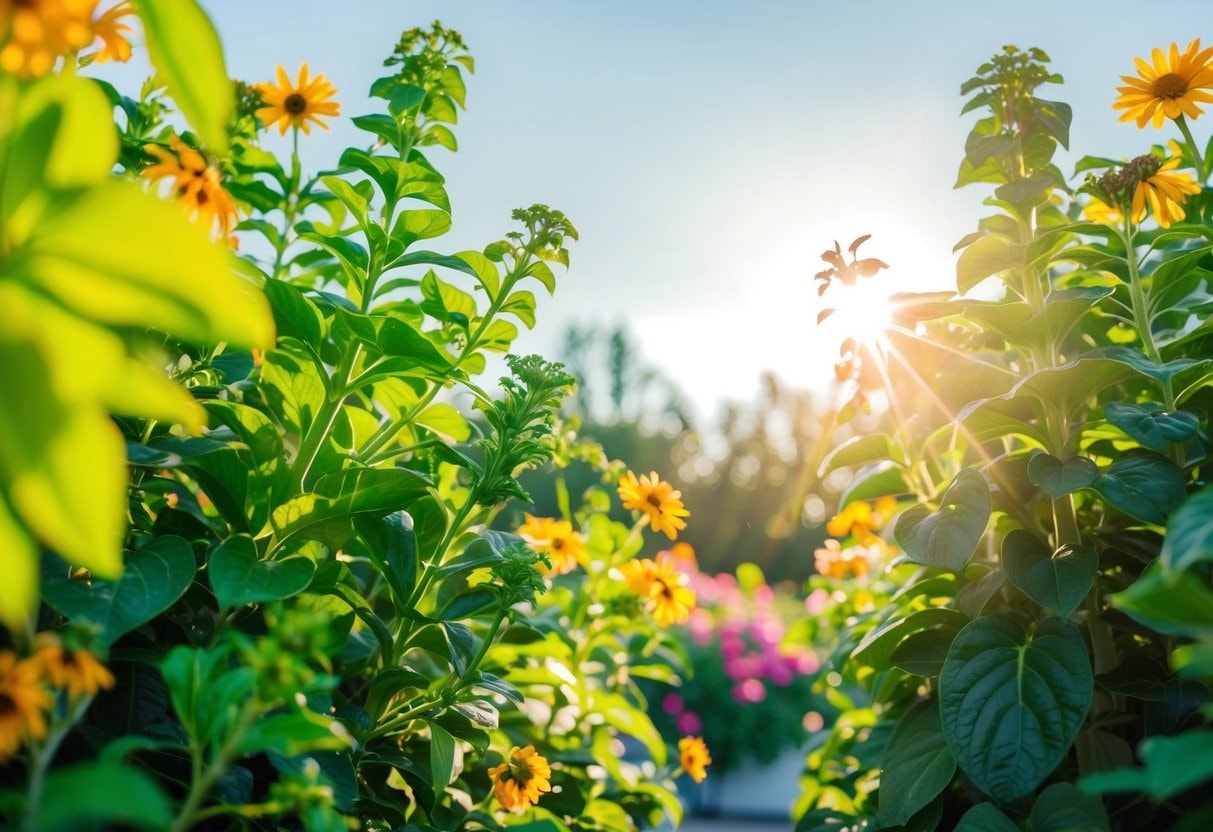HousePlantJoy is supported by our audience. When you purchase through one of our links, we may earn a small affiliate commission. As an Amazon Associate I earn from qualifying purchases. Your cost is not affected.
==================
Research on plants and positive emotions has revealed an intriguing connection between greenery and our mental well-being. Studies show that simply being around plants can elevate mood, reduce stress, and foster a sense of calm. As people increasingly look for natural ways to enhance emotional health, the role of plants is gaining more attention.
The benefits extend beyond aesthetics, as indoor greenery creates a nurturing environment that supports mental clarity and emotional balance. Whether it’s a potted fern or a full-blown garden, the presence of plants can significantly impact how we feel. Let’s explore the science behind this connection and how you can harness the power of plants to improve your mood and emotional health.
The Science Behind the Smile: Research on Plants and Positive Emotions – Nature’s Mood Boosters Revealed
Smiles are powerful. They can brighten our day and make us feel good. But did you know that plants can also make us smile? I’ve always been fascinated by how nature affects our emotions. It turns out there’s actual science behind this connection. Research shows that flowers can trigger genuine smiles and positive feelings in people. This isn’t just a hunch – studies back it’s. For example, women who received flowers always showed true smiles.
These weren’t fake smiles, but the real deal that lights up your whole face. Plants do more than make us smile. They can boost our mood and even help us feel less lonely. It’s incredible how something as simple as a flower can significantly impact our emotions. This got me thinking about how to use this knowledge daily to feel happier and more connected.
Exploring the Connection Between Plants and Positive Emotions
Research on plants and positive emotions reveals that plants have a powerful effect on our emotions and well-being. Studies have found that being around greenery can boost mood and reduce stress. Let’s explore how research on plants and positive emotions shows plants’ impact on our mental state and the benefits of caring for them.
Psychological Impact of Green Spaces
Green spaces make me feel calmer and happier. Studies show that being in nature improves mood and lowers stress levels. Even looking at plants can help. I’ve noticed that parks and gardens lift my spirits. The colors and scents of flowers are especially uplifting.
Research backs this up – receiving flowers can boost positive emotions for days. Plants in offices and homes create a more positive environment, too. I find that indoor plants make spaces feel more welcoming and peaceful. This can lead to better focus and productivity.
Emotional Benefits of Gardening and Plant-Care
Taking care of plants gives me a sense of purpose and accomplishment. Gardening reduces stress and anxiety while boosting self-esteem. I love watching my plants grow and thrive. It’s rewarding to nurture something and see the results. This process can be very calming and meditative. Gardening also connects me with others. Sharing plants or gardening tips helps build relationships.
Community gardens are great for making friends and feeling part of something bigger. Caring for plants teaches me patience and mindfulness. I have to pay attention to their needs and be present in the moment. This focus on the present can ease worries about the future.
The Science of Plant Perception and Emotions
Research on Plants and Positive Emotions reveals that plants have amazing ways of sensing and reacting to their world. While they don’t have brains like us, research shows they can respond to touch, light, and other stimuli in complex ways. Let’s explore how plants perceive their environment and how we relate to them emotionally.
Anthropomorphism and Emotional Attachment to Plants
I’ve noticed that many people form strong bonds with their houseplants. We often talk to our plants or give them names. This is called anthropomorphism – seeing human traits in non-human things. While plants don’t have feelings like we do, our emotional attachments to them can be genuine. Some studies show that caring for plants can reduce stress and improve mood.
It is fascinating how plants can sense touch and respond to gentle handling. This may partly explain why we feel connected to them. Gardening and plant care can give us a sense of purpose and accomplishment. Even if plants don’t love us, nurturing them can be deeply satisfying.
Studies on Plant Awareness and Sensory Responses
Plants are more aware of their surroundings than we once thought. I’ve learned that they can perceive light, gravity, water, and touch. Some fascinating research shows plants respond to sound vibrations and even release chemicals to communicate with each other. For example, when attacked by insects, some plants release scents that attract predators of those insects.
They can also send chemical signals through their roots to warn nearby plants of danger. While plants don’t have a nervous system like animals, they have ways of sensing and reacting to their environment. Some scientists are studying plant behavior and intelligence in new ways. This research is helping us better understand how plants function and adapt.
The Effect of Plant-Interaction on Stress Reduction
When I spend time with plants, I feel calmer. This isn’t just in my head – it’s backed by science. Studies show that being around plants can lower our stress hormones. I’ve noticed that gardening helps me relax. It turns out this is common. Touching soil and leaves can reduce our body’s stress response.
Even looking at plants can help. Indoor plants at work or home can make a difference, too. They can lower our stress levels throughout the day. This effect happens even if we don’t actively interact with the plants.
Measuring Changes in Heart Rate and Blood Pressure
Plants don’t just make us feel good – they can improve our physical health too. I was amazed to learn that being around flowers can change our heart rate and blood pressure. When we’re near plants, our heart rate often slows down. This is a sign that our body is relaxing.
Our blood pressure can also drop, which is great for our health. These changes happen quickly. Even a short time in a garden or park can have benefits. It’s exciting to think that something as simple as a houseplant could help our hearts!
Key Research Findings on Plants and Happiness
Research on Plants and Positive Emotions shows that plants have a powerful effect on our emotions and well-being. Studies reveal they can boost mood, reduce stress, and improve brain function. Let’s explore some key findings from neuroscience and long-term research.
Evidence from Neuroscientific Studies
Brain scans reveal that looking at flowers activates reward centers in our brains. This triggers the release of feel-good chemicals like dopamine and serotonin. I find it fascinating how something as simple as a plant can significantly impact our brains. Studies also show that being around plants can:
- Lower blood pressure.
- Reduce anxiety.
- Improve focus and memory.
Even just seeing pictures of nature scenes lights up parts of our brain linked to empathy and love. How deeply we’re wired to connect with plants and nature is fantastic.
Longitudinal Research on Emotional Well-being
Long-term studies give us a clearer picture of how plants affect happiness over time. One 3-month study found that people who received flowers reported feeling happier for days afterward. They also smiled more and were more social. Other key findings from multi-year studies include:
- Gardening lowers the risk of depression.
- Having plants at work boosts job satisfaction.
- Green spaces in cities improve overall life satisfaction.
I’m excited by research showing that caring for plants during lockdowns helped people cope with stress and isolation. Clearly, our connection to plants runs deep and has real benefits for our emotional health.
Incorporating Plant Life into Daily Living
I like to keep small potted plants on my desk at work. They add a nice pop of color and help me feel more relaxed. I’ve noticed my mood improves when I take a few minutes to water and care for them each day. Adding a vase of fresh flowers can make people smile and feel happier.
I pick up a bouquet every week to brighten my living room. Even looking at floral artwork or photos can have a positive effect. Spending time gardening outdoors is another great option. I find digging in the dirt and watching plants grow very rewarding. It’s a fun hobby that gets me outside in nature more often.
Designing Spaces with Biophilia in Mind
When decorating, I look for ways to bring nature indoors. Adding natural materials like wood and stone creates a calming vibe. Large windows with views of greenery let in lots of natural light. I’ve started incorporating more plant-inspired patterns and nature scenes in my decor. Leaf prints on pillows or landscape paintings can promote well-being.
Even artificial plants can provide some of the mood-boosting benefits of real ones. Creating a small indoor garden or terrarium is a fun project. I enjoy tending to it and find it very relaxing to look at. Water features like fountains add nice natural sounds to a space, too.
Impact of Urban Greenery Projects
Cities with more green spaces tend to have happier residents. High Line Park turned an old railway into a garden walkway in New York City. Visitors often smile as they stroll through the flowers and trees. Another project I studied was in Singapore.
They added plants to building roofs and walls. People who worked in these “green” buildings reported feeling less stressed. I also noticed that neighborhoods with more trees had lower crime rates. This suggests that urban greenery might help create safer, friendlier communities.
Analysis of Horticultural Therapy Programs
I’ve seen excellent results from garden therapy programs. These use plants to help people heal both mentally and physically. One program I looked at worked with veterans with PTSD. They spent time planting and tending a vegetable garden. After a few months, many said they felt calmer and slept better.
I also studied a program for kids with ADHD. They did gardening activities twice a week. Teachers noticed the kids could focus better in class afterward. Flowers seem to have a unique power to lift moods. In one study I read, people who received flowers as gifts smiled more and felt happier for days afterward.
The Profound Connection: Plants Influence Our Emotions and Smiles
In conclusion, research on plants and positive emotions highlights a compelling connection between greenery and our mental well-being. Studies demonstrate that plants can significantly elevate mood, reduce stress, and foster a calming environment. Whether creating serene green spaces or incorporating houseplants into our daily lives, the benefits of being around plants are profound and accessible. Integrating plants into our surroundings offers a natural and effective way to enhance emotional health and create a more positive atmosphere.
The impact of plants extends beyond mere aesthetics. Evidence shows that interacting with plants can lower stress levels, improve focus, and improve physical health. From the simple act of caring for a potted plant to designing spaces with biophilic elements, science supports the idea that plants are potent allies in boosting our mood and overall well-being. Embracing this connection can lead to a happier, more balanced life, demonstrating that nature’s touch has real and lasting benefits for our emotions.
How Do Plants Influence Our Emotions and Contribute to Feelings of Happiness?
What Has Recent Neuroscience Research Revealed About the Act of Smiling?
Can the Act of Smiling Lead to a More Positive Mood?
Expand Your Plant Passion with Our Community!
Explore the fascinating world of houseplants and connect with fellow enthusiasts. Join us on social media for engaging content, insightful product reviews, and essential plant care tips.
Join us today! Follow Houseplant Joy on Facebook, Instagram, and Twitter for daily inspiration and a blooming good time! #HouseplantJoy














